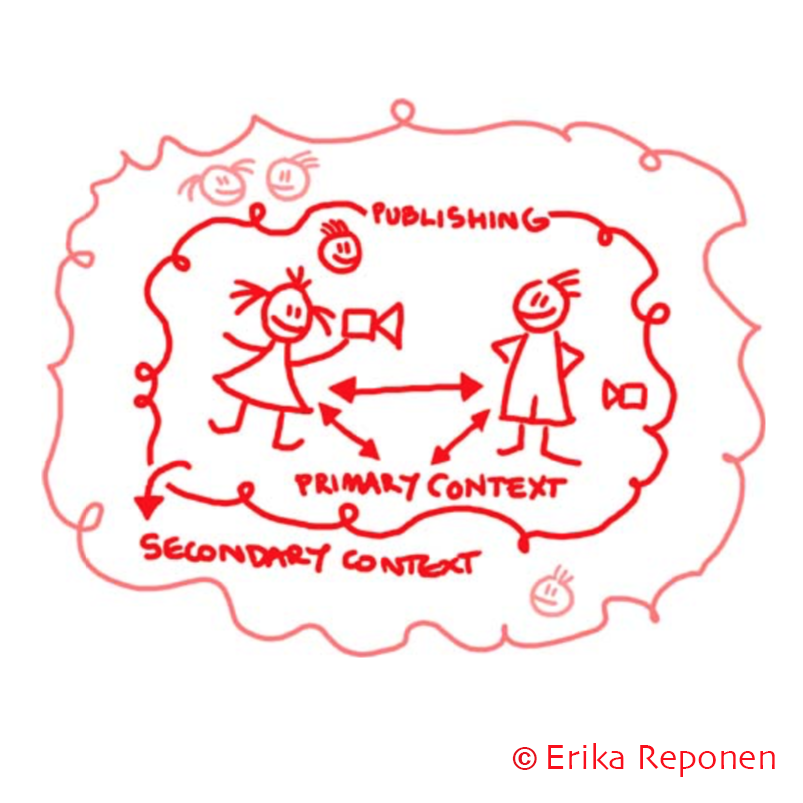Erika Reponen, Doctor of Arts Dissertation (2020): “Mobile Video Communication 2005-2010”,
University of Lapland, ISBN:978-952-337-210-8
Acta electronica Universitatis Lapponiensis.
The permanent address of the publication is http://urn.fi/URN:ISBN:978-952-337-210-8
Referred personal interviews:
Summary:
Mobile video communication, even in real time, became possible in 2005 enabled by video capabilities and internet connections of mobile phones. This dissertation describes the development of mobile video communication between 2005-2010. The main theme and inspiration of my research is that it is possible for anyone with a mobile phone to record and share a webcast without external censorship. This can even happen in real time and so that anyone can see the video when it happens. This completely new type of communication brings with it opportunities and challenges. I examine this phenomenon.
In my research, I aim to bring understanding and tools to help deal with this phenomenon in which the production of media content is transferred from large companies to individuals as well. The possibilities for communication and content creation expand considerably because video cameras are now present and accepted almost always and everywhere.
The main research question of my qualitative research is: “How has mobile video communication developed between 2005-2010”. I will look at this question through four sub-studies. In them, I address the emergence of mobile video communication (I), motivations and attitudes toward mobile video communication (II), as well as mobile live video practices (III) and content (IV). I also use concept analysis: I discuss the terms mobile, video, and communication and their polysemias, individually and together, to build a theoretical foundation for my research and broad understanding of the topic. The studies have been carried out as a literature study, two user studies (field study and an experiment) and content analysis. I have utilised also findings of media-archaeology.
In my research, I present a model of primary and secondary context in which the camera, and in particular the publishing, act as an enabler between the two. I also made a definition for mobile video communication: in addition to video, I includeded audio as well as text as an important element of it. According to the research results, motivations for recording mobile video include storing for own use and sharing the videos with others. It is common that people get used to presence of camera and filming within a month, and after that starting to take filming neutrally. I consider that video getting mundane increases the threat of privacy loss that mobile video communication brings with it. While mobile video enables publicity and fame, it also affects privacy and security by bringing situations to the attention of several new eyes. Also the concepts of truth and reality are closely related to this. Realtime mobile video in particular often provides a realistic picture of events, but it is also possible to be edited to some extent. I propose that increase in the number of cameras increases the truthfulness of the video. During the research period, big part of the live videos were tests and demos, due to the novelty of the technology. Still, it was clear that mobile video communication could be used for both entertainment and utility purposes, ranging from jokes, interviews and sharing experiences to citizen journalism and security. The presence of a video camera affects the situation until people get completely used to it.
Alongside the old familiar filming subjects, new themes such as sudden events, notes, and tours have emerged with mobile video. I present the special characteristics of mobile video communication, which I define with the help of the research results of the sub-studies and the triangle of mobile video communication, as well as other background research. First person point of view is very typical characteristics of mobile video communication and I conclude based on the research results that its importance will increase even more with the proliferation of wearable cameras such as head-up displays. According to the research results, video viewers consider commenting and narration an important part of mobile video. Internal coordination speech in the video recording situation is also common. Based on my research, considerable difference between live video and video that is shared later is that live video often shares context while recorded video shares content. The live video tends to be unpredictable and its quality requirements remain lighter compared to on demand video, which is often edited and planned.
As my main research result, I present how mobile video communication expands context from primary to a secondary one.
My research provides tools to understand and address the change brought by mobile video communication for both the individuals and society. My work can be utilised for example in product development and education. The model of primary and secondary context can be used to describe situations where the recording and sharing technology is present. Interesting topics for further research can be found in future communication in general and, for example, relationship of editing, augmented reality and drones to it.
Model of Primary and Secondary Context illustration
Doctor of Arts Dissertation Cover 2020 - Mobile Video Communication 2005-2010


